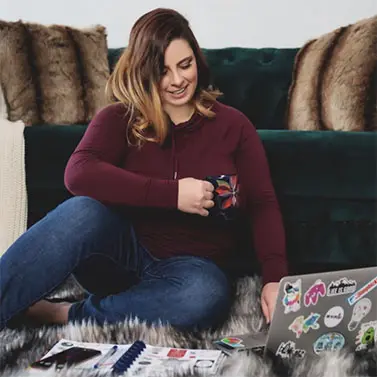
Casey Mank
Casey Mank is the Co-Founder of Bold Type, a women-owned writing consultation firm based in Washington D.C.
Use The Words Your Audience Really Uses
If I could only give someone a single SEO tip, it would be: use the words your audience really uses. Knowing your audience and how they talk, text, and think is essential for effective SEO. It’s no use to load your content with keywords that your audience doesn’t know or wouldn’t think to search. As a product or subject matter expert, it can be very easy to lose sight of how non-specialists would really talk about your content.
Here’s a simple test to avoid jargon and speak to your audience in their own words: imagine that someone in your target audience reads your content and then walks to the coffee shop to meet a friend. Without your content in front of them, how would they explain what they just learned in everyday, conversational words? If you’re not using and frontloading those words in your content, you’re missing a big SEO opportunity. Speak to your audience in their own language, and you’ll be using the words they think, purchase, and search with.
Focus On Quality, Not Quantity
Track your most trafficked pages, be it blog posts or other pages, and continually improve the content to expand on additional keyword-based topics on those pages to maximize reach. It is better to grow and capitalize on one highly successful piece of content than to pump out several less effective content pieces.
Furthermore, repurpose and repromote said content as necessary. Don’t be afraid to share the same content more than once over time with your readership and followers, especially when you have revamped it to include additional information like a table or chart, original data, or a printable PDF resource.

Rebecca Graham
Rebecca Graham, Content Manager at Best Company. With a BA in English from BYU, Rebecca has always utilized and embraced the impact of words and has grown to harness the power of data in her role as the business services content manager for the data-based review site Best Company.

Jolene Rheault
Jolene Rheault, Owner of refreshing-solutions.com. Jolene is an engaging, intelligent, and profoundly relevant digital marketer, content creator, and social media manager who has begun to explode onto the marketing scene.
3 Best Actionable SEO Tip
Write as much content as possible. Google’s new algorithm is looking at content much more than if a keyword is used frequently. Experts are suggesting using a length of 1500-2000 words to get good organic and google rankings. Additionally, 1500- 2000 words in a piece of content will provide extra SEO optimization and increase the audience reach.
Use keywords strategically. It’s much better to place a keyword at the beginning of a title for a post or page than at the end of it. Furthermore, make sure that your URL slugs include your keywords, that you are including the keywords in the alt tags of your images, and that you are using the keyword within the content in a natural-sounding manner.
Do your keyword research. If you’re using a keyword that has a lot of searches on Google and there’s no competition out there, the odds of ranking for it will be much higher. Likewise, if your keyword has no searches or a lot of content that is already ranking for it, the odds of your ranking for it will be very low.
Update Old Content And Display The Date Correctly
After thoroughly testing this, we can conclusively say that Google heavily favors fresh, up-to-date topics, even on evergreen topics. Early last year, we began revising our old content, and most importantly, adding the revision date to the schema markup. As a result of this, we saw an overnight boost in rankings that made a significant impact on our traffic almost instantly—and with very little work!
You don’t have to completely rewrite your article every month, but going through it, ensuring all the information is still correct, making any minor adjustments needed and noting that the article has been updated as such is enough to trigger Google to see that your article is fresh and worth ranking.
If you’re looking for a quick and easy win, this is definitely it!

Mark Webster

Kevin Pike
Kevin Pike is President and owner of Rank Fuse Digital Marketing. His expertise includes Pay-Per-Click (PPC) management, WordPress development, and Search Engine Optimization (SEO). Kevin is best known for digital strategy and execution across search, display, and content campaigns.
Monitor Your Website Regularly And Fix Broken Links
One actionable SEO tip I can offer anyone is to set up a regular process to monitor and fix broken links. Doing a regular scan of your website’s links eliminates negative UX issues as well as technical SEO penalties.
Broken links are inevitable, especially the ones you point to external sites you don’t control. For publishers with higher volumes of content to manage this should be a weekly or monthly exercise. In my experience, smaller corporate websites (with less publishing) can scale this back to a quarterly exercise.
The tools for this job can vary based on your approach and preferred method. For DIY folks who like manual scanning tools, I suggest downloading Screaming Frog. For automated tools, you can look at your Google Search Console data, or use paid audit tools like SEMrush or Moz.
Review And Optimize Your Page Titles
My single best actionable SEO tip would be to review and optimize your page titles. No matter what level of knowledge you have regarding SEO, this is one of the most simple things to get your head around and can be done without any tools. It’s also one of the most overlooked elements of SEO and can provide a significant improvement to your rankings once they have been optimized.

Ryan Scollon

Marcus Miller
Marcus Miller, SEO & Digital Marketer at the UK Agency Bowler Hat. I have worked in the digital marketing industry for over 20 years now and currently run the UK agency Bowler Hat.
Map Keywords To Pages Correctly
A common problem we see across sites of all shapes and sizes, is a failure to map keywords to pages correctly. So, the site may be targeting several keywords, but they are targeted on several pages. So Google, or any other major search engine, will not be crystal clear which page should return for which keyword. This creates confusion and impacts the ability of any of these pages to rank for your targeted terms. It also impacts user experience and conversion as potential customers may enter the site on the wrong page. Create a list of keywords, allocate them to specific pages, then ensure your on-page optimization, internal linking, and any external linking all reinforce this strategy.
Determine The Searcher’s Intent And Match It
Before you try to rank a page for a set of keywords you should search for those keywords on the search engine you’re focused on and examine the results — especially if you’re targeting Google.
See what types of pages are ranking on the first page and use that as an indication of what type of content you should create. If the first page is ranking things like guides and how-to type articles then you’ll be wasting your time trying to rank something like an ECommerce product page.

Skyler Reeves

Gintaras Steponkus
Question Keywords For Answering User Intent
Question keywords for answering user intent: Google is becoming the answer engine from the search engine. In previous years, we used [Google] only to get the website links in search engine results. However, now it shows us text, video, images, and maps in the form of featured snippets as per the query requirements.
Google has started focusing on the user intent, so SEOs should target the “question keywords” along with the other keywords as well. Several tools generate hundreds of question keywords against a particular keyword. If you want to get the precise data, then using tools like Ahref and SemRush would show the exact search volume and difficulty score against the particular term. Choose the low hanging fruit – one with less difficulty but the potential to bring traffic.
Tip: Reddit and Quora are themselves the mini search engines now. So, the type of questions asked at a higher frequency at these platforms reflects the interest of the majority of people. There are some tools available that can search their database and generate the question keywords accordingly. Using such tools would be a wiser strategy.
If you [can] answer the question precisely, then [the content can appear in the] featured snippet. For example, at zero rank position, the content that gets featured will provide the maximum value in 60-70 words. Your focus should be on the quality more than the quantity.
Speed Up Your Website
The best SEO tip that I can give you is to make sure that your website loading speed [is good]. If there is something that hurts your overall user experience, conversion rates as well as SEO performance, it’s poor loading speed. Just a few extra seconds of loading time means a significantly higher bounce rate, which search engines interpret as a bad ranking signal. While a website that loads faster won’t solve all of your SEO problems, it will noticeably improve your SEO results. Do a technical audit and see how fast your website loads and go from there.

Malte Scholz
Malte Scholz is a passionate product manager and technology enthusiast with deep knowledge in launching cross-platform SaaS and e-commerce products. Malte co-founded Airfocus – a software solution that enables smarter roadmap prioritization for teams and solopreneurs.

David Lynch
David Lynch is the Content Lead for Payette Forward, Inc., a digital publishing company focused on cell phones and cell phone plans.
Start Incorporating Video Into Your Content Strategy
Google has increasingly made video content more visible on search engine results pages. Some videos even appear as a featured snippet.
With YouTube emerging as the second most popular search engine, it’s more important than ever to begin creating video content. Creating a YouTube channel gives you a cost-free place to upload your video content, reach a wider group of people, and build an audience on a new platform. Additionally, YouTube can become a new revenue stream for your business.
One great way to start is to use your existing written content as scripts for video content. This is the strategy our business applied to YouTube when we first started uploading.
Incorporate Visuals Into Your Blog Content
Leveraging visuals such as high-quality videos and infographics in your content strategy correlates to many ranking factors—traffic, higher engagement and user experience, lower bounce rate, and backlinks opportunity.
Visuals improve user experience and add value to your content. This translates to higher engagement. Almost 75% of online traffic is from video content, so this is an engagement opportunity you can’t miss out on.
Visuals in your content can [drive] an influx in traffic and a higher conversion rate. Users tend to stay longer on webpages with visuals related to their searches. When I started pairing my blog contents with relevant learning video materials, I noticed my bounce rates decreased, which significantly affects search ranking.
Moreover, high-quality videos and infographics make learning faster and your content more appealing. They are also shareable, making [visuals] an excellent source for getting backlinks. Infographics are visual representations of data, so make sure they’re accurate, useful, and relevant to the content you’re pairing them with.

Mason Culligan
Mason Culligan is the founder of Mattress Battle, a multimedia company he created two years ago, which provides guides and evidence-based sleep information.
This is a crowdsourced article. Contributors are not necessarily affiliated with this website and their statements do not necessarily reflect the opinion of this website, other people, businesses, or other contributors.